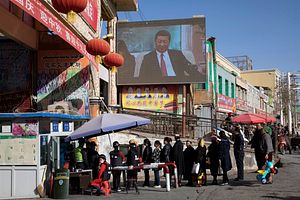President Xi Jinping’s ascension to a position of power unparalleled since that of Mao Zedong has been underscored by last October’s Chinese Communist Party (CCP) congress – which hailed him as “the core” of the CCP – and the recent move to abolish the presidency’s two-term limit. With this, the New York Times’ Steven Lee Meyers argues, China now definitively enters “the strong-man era.” According to this line of thinking, then, Xi is constructing a highly personalized form of authoritarianism a la Russian President Vladimir Putin’s.
However this understates the scale and scope of the Party’s endeavors to ensure control under Xi.
In his 2016 book, China’s Future, David Shambaugh speculated on four possible pathways for the country’s political future: a status quo “hard authoritarianism,” a “soft authoritarianism” of the “Asian Tigers” type, a Singapore-style “semi-democracy,” or a hard “neo-totalitarian” turn. “Neo-totalitarianism,” Shambaugh suggested, could be triggered by a combination of a sudden crisis and/or the assertion of “hard-line leaders and their coercive bureaucracies” and become manifest through not only the reassertion of the institutions and instruments of social control of the Maoist era but their augmentation via 21st century technological innovations.
That such a “neo-totalitarian” turn is in fact not only possible but already underway can be seen through an examination of the “security state” the Party has erected over the past decade in the Xinjiang Uyghur Autonomous Region.
Xinjiang’s geopolitical position – sharing borders with Russia, Mongolia, the Central Asian republics, Afghanistan, and Pakistan – and Turkic-Muslim ethnic groups such as the Uyghur have always made Beijing both vigilant about its security and apt to respond with a heavy hand to outbursts of anti-state violence and unrest.
Since Xi’s ascension to the presidency, however, “security” has been elevated to a consuming priority in Xinjiang.
This has been driven by both periodic terrorist attacks in or connected to Xinjiang by Uyghurs, such as the March 2014 Kunming train station attack, which Beijing has sought to link to externally-based and al Qaeda-affiliated organization, the “Turkestan Islamic Party” (TIP), and the region’s role in Xi’s signature “Belt and Road Initiative” (BRI). Xi has declared that “long term stability” in Xinjiang – a hub for three of the six proposed “economic corridors” linking China to South Asia, the Middle East and Europe under BRI – is vital to the initiative’s success.
This has resulted in the intensification of long-standing strategies of control augmented by a variety of innovations and a rapid increase in expenditure on domestic security. The state’s efforts to harness technological innovation has been evident in the implementation of measures to ensure the “comprehensive supervision” of the region via installation of China’s “Skynet” electronic surveillance system in major urban areas, installation of GPS trackers in all motor vehicles, use of facial recognition scanners at checkpoints, train stations, and even petrol stations, provision of DNA samples from the local population, and collection of biometric data for passports.
Such methods amount to a vast experiment in “predictive policing,” whereby the authorities are able to assess an individual’s identity and ethnicity, social interactions, use of social media, and physical movement to ascertain their relative “threat” to the state and better direct operations of security forces.
As Adrian Zenz a researcher at the European School of Culture and Theology in Germany, has revealed, Xinjiang’s regional government spent $9.1 billion on such domestic security measures in 2017, constituting a 92 percent increase on such spending in 2016.
This expanded system of surveillance has also been backed not only with force, displayed most overtly through such measures as mass “anti-terrorism” rallies of thousands of security personnel in Xinjiang’s major cities, but also, most disturbingly, by mass social coercion not seen since the height of the Cultural Revolution.
Not only has the Party ramped up its efforts to systematically regulate and control religious practice, including through dissemination and enforcement of new guidelines for the identification of potential “deviant” behaviours amongst believers, but also begun to send thousands – perhaps up to 900,000 according to one estimate – of Uyghurs to political “re-education camps” based on analysis of the data harvested through its system of “predictive policing.”
Here, receiving a phone call from a relative studying or traveling overseas can result in an almost immediate visit from local police and indefinite detention in a “re-education” center. Revealing the logic of the state’s approach, a Party official in Kashgar remarked in reference to such measures, “You can’t uproot all the weeds hidden among the crops in the field one by one — you need to spray chemicals to kill them all.”
Xi may have proclaimed that BRI will “benefit people across the whole world” as it will be based on the “Silk Road spirit” of “peace and cooperation, openness and inclusiveness,” but this rhetoric that is far removed from the “neo-totalitarian” reality confronting Uyghurs in Xinjiang.
Dr. Michael Clarke is Associate Professor at the National Security College, Australian National University. He is the author of Xinjiang and China’s Rise in Central Asia: A History (Routledge 2011) and editor of the forthcoming Terrorism and Counter-Terrorism in China: Domestic and International Dimensions (Hurst 2018).
































